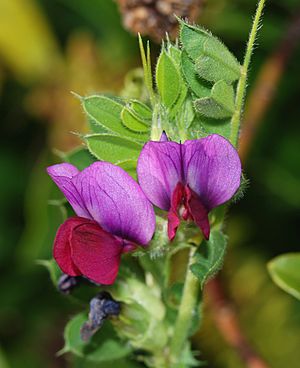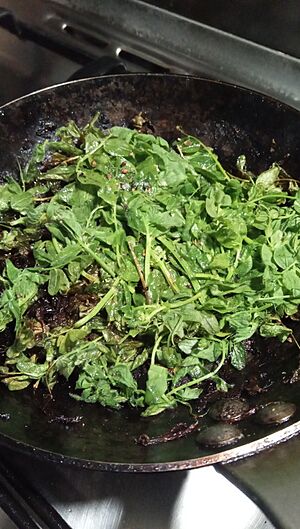Vicia sativa facts for kids
Quick facts for kids Common vetch |
|
|---|---|
 |
|
| Scientific classification | |
| Genus: |
Vicia
|
| Species: |
sativa
|
The common vetch (scientific name: Vicia sativa) is a fascinating plant that helps the soil. It's also known as garden vetch or tare. This plant is a type of legume, which means it belongs to the pea family (Fabaceae). Legumes are special because they can take nitrogen from the air and put it into the soil, helping other plants grow. Even though it's sometimes seen as a weed in grain fields, farmers often grow common vetch on purpose. They use it as "green manure" to make the soil healthier or as food for livestock like cows and horses.
Contents
What Does Common Vetch Look Like?
Common vetch is an annual plant, meaning it lives for only one growing season. It has long, sprawling stems that can grow up to 2 meters (about 6.5 feet) long. These stems are hollow and have four sides.
The leaves of the common vetch are made up of several smaller leaflets. Each leaf has 3 to 8 pairs of these small leaflets, which can be shaped like lines, spears, or wedges. At the end of each leaf, there's a special branched tendril. These tendrils act like tiny grappling hooks, helping the plant climb and hold onto other plants for support.
The flowers look a lot like peas. They grow where the leaves meet the stem, either alone or in pairs. Each flower is about 1 to 3 centimeters (0.4 to 1.2 inches) long and is usually a bright pink-purple color. Sometimes, you might see white or yellow flowers. Bumblebees love to visit these flowers!
After the flowers bloom, they turn into a legume pod. This pod can be up to 6 or 7 centimeters (about 2.8 inches) long. When it's new, it's a bit hairy, but it becomes smooth later. When the pod is ripe, it turns brown or black and holds 4 to 12 seeds inside.
How Farmers Grow Common Vetch
Farmers plant common vetch for different reasons. If they want to grow it for fodder (animal food), they plant a lot of seeds close together. But if they want to collect the seeds, they plant fewer seeds so the plants have more space to grow flowers and seeds.
For good seed production, it's best to plant common vetch early in the spring. If farmers are growing it to improve the soil (as green manure), they can plant it any time in the spring. After planting the seeds, the field is smoothed out with a roller. Farmers also keep an eye on the field for a few days to make sure pigeons don't eat too many of the newly sown seeds!
Vetch as Animal Food
Common vetch is excellent food for animals like Horses and cattle. Animals often grow stronger and healthier when they eat vetch compared to other grasses. However, it's important that animals don't eat too much vetch, especially when the pods are ripe. Eating too much can cause stomach problems like colic.
Growing Vetch with Other Plants
Because common vetch has weak stems, it often needs help to grow upright. Farmers sometimes plant it with Cereal grains like oats. The vetch uses its tendrils to attach to the stronger stems of the grains, allowing it to grow tall instead of sprawling on the ground. There are many different types of common vetch that farmers can choose from. Sometimes, special bacteria called rhizobia are added to the seeds to help the plant fix even more nitrogen in the soil.
Pests That Affect Vetch
Like all plants, common vetch can be attacked by pests. Some common pests include a fungus called powdery mildew, tiny insects called pea aphids, and caterpillars like the corn earworm and the fall armyworm. Tiny spider mites can also cause problems for the plant.
A Story About Vetch Seeds
A long time ago, in the early 1900s, a special type of common vetch appeared. Its seeds looked very similar to lentils. This caused a problem because vetch seeds would mix in with lentil crops. However, a scientist named D. G. Rowlands discovered in 1959 that this was due to a simple genetic change. Luckily, with modern farming machines, it became much easier to separate the vetch seeds from the lentils, solving the problem.
A Look Back in History
Common vetch has been around for a very long time! Scientists have found burnt remains of common vetch at ancient sites from the Neolithic period (the New Stone Age) in places like Syria, Turkey, and Hungary. It has also been found at very old sites in ancient Egypt and during the Bronze Age in places like Turkmenistan. This shows that people have known about and used common vetch for thousands of years. However, clear proof that people were growing it on farms only comes from Roman times.
You might have heard the word "tare" in old stories, like in some English translations of the Bible (for example, in the "Parable of the Tares"). In those stories, "tare" might have referred to a different plant called darnel ryegrass, not necessarily common vetch.
How Common Vetch Got Its Name
The famous scientist Carl Linnaeus first officially described Vicia sativa in his book Species Plantarum in 1753. Since then, many other names have been given to this plant, but Vicia sativa is the main accepted name.
Scientists also recognize at least four main types, or subspecies, of common vetch:
- Vicia sativa subsp. cordata
- Vicia sativa subsp. nigra (also known as narrow-leaved vetch)
- Vicia sativa subsp. sativa
- Vicia sativa subsp. segetalis
Images for kids
See also
 In Spanish: Arveja para niños
In Spanish: Arveja para niños



